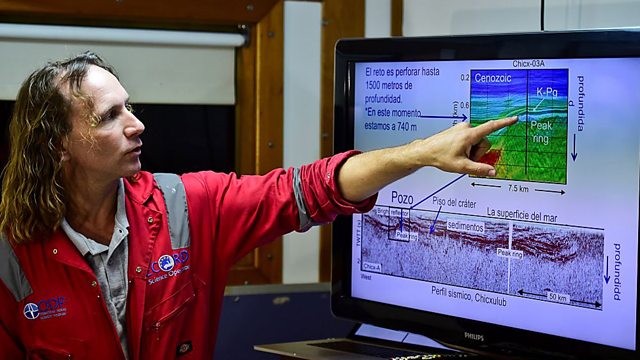
Drilling the ‘Dinosaur Crater’
Dinosaur crater; The deep origins of bird song; Poverty fuels disease in rich countries; Phonagnosia; Life on Mars?; Wooden skyscrapers
Scientists have obtained remarkable new insights into the asteroid impact that wiped out the dinosaurs. They have been examining rock drilled from the Chicxulub Crater, made by a 15km-wide asteroid, dug out of what is now the Gulf of Mexico some 66 million years ago.
The Deep Origins of Bird Song
Palaeontologist Julia Clarke has discovered the oldest fossil of a bird's organ of song, the syrinx. At the University of Texas, Austin, the delicate structure turned up in an X ray scan of a 66 million year old bird fossil from Antarctica. The fossil syrinx is so well preserved it is possible to say what the call of this ancient bird, Vegavis, would have sounded like. It is also a massive boost in the quest to discover when birds first sang and recreating the dawn chorus back in the Age of Dinosaurs.
Poverty Fuels Disease in Rich Countries
Despite progress in reaching global health targets a number of neglected tropical diseases are now spreading in richer countries – causing disability and hardship. One American expert says that eradicating them could help to stimulate economic prosperity as well as end suffering.
Phonagnosia
The inability to recognise voices – even those of family members or well-known celebrities – is known as phonagnosia. A psychologist in California has been examining the condition using a test with celebrity voices. One woman who volunteered to take part cannot even recognise her own mother’s voice on the phone.
Life on Mars?
Mars is about to be visited by the first space mission for 40 years which is designed to seek signs of life on the Red Planet. Adam Rutherford talks to Dr Manish Patel of the Open University, a senior scientist on the European Space Agency's ExoMars Trace Gas Orbiter. Once the spacecraft starts work, it may solve the mystery of ebbs and flows of methane gas in the Martian atmosphere. It may answer whether the gas is being produced by life beneath the planet's cold dusty surface.
Meanwhile, down on the surface, NASA’s Curiosity rover has reached the foot of Mount Sharp. It is a promising place to search for life as there is some evidence for liquid water being present. Paradoxically however, Curiosity is going to keep a safe distance so as to avoid the possibility of contaminating the region with any microbial stowaways carried there from earth deep inside the rover’s chassis.
Wooden Skyscrapers
New ways to engineer and build with wood, a huge demand for housing and concerns about the high carbon cost of steel and concrete mean architects and engineers are looking to sustainable wood to build our high rise buildings.
(Photo caption: Geophysicist Sean Gulick and the expedition to drill into the Chicxulub Crater, created after an asteroid crashed 66 million years ago © Ronaldo Schemidt/AFP/Getty Images)
The Science Hour was presented by Claudia Hammond with comments from ´óÏó´«Ã½ News science reporter Victoria Gill
Editor: Deborah Cohen
Last on
More episodes
Previous
Next
Broadcasts
- Sat 15 Oct 2016 08:06GMT´óÏó´«Ã½ World Service Australasia
- Sat 15 Oct 2016 22:06GMT´óÏó´«Ã½ World Service except News Internet
- Sun 16 Oct 2016 01:06GMT´óÏó´«Ã½ World Service Australasia
- Mon 17 Oct 2016 05:06GMT´óÏó´«Ã½ World Service South Asia
Podcast
-
![]()
Unexpected Elements
The news you know, the science you don't

